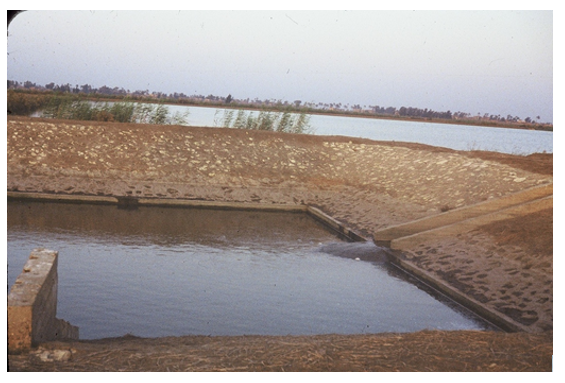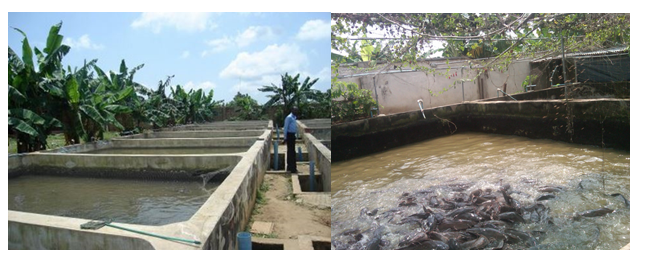Back to: AGRICULTURAL SCIENCE SS3
Welcome to class!
In today’s class, we will be talking more about fish farming. Enjoy the class!
Fish Farming II

A fish pond is an artificial body of water in which fishes are reared for commercial purposes. There are various types of a fish pond. It is a confined body of water where fishes are raised under controlled conditions. Fish can also be raised in plastics, fibre stars and wooden rafts.
There are three types of the pond:
- Earthen pond
- Concrete pond
- Plastic pond
Earthen pond
This involves digging the soil usually clay (25 %clay) to a depth ranging from 0.5- 1.0 m at the shallow end and 1.5 – 2.0m at the drain end to raise fish. The pond can be of any shape as long as it is well constructed. However rectangular or square shapes are considered the best. This is usually practicable in swamping environment. This rule away the problem of water maintenance as there is a natural flow in and out of water in the pond
Excavated pond:
An excavated pond is often built on level terrain and its depth is achieved solely by excavation. An excavated pond is relatively safe from flood damage, is low maintenance and can be built to expose a minimum water surface area in relation to volume. This is beneficial in areas of high evaporation losses and a limited amount of water supply. Ponds should have gentle slopes on dikes as depicted in the Figure below

Embankment pond:
This type of pond is built by creating an embankment or dam used to impound water and is usually constructed in a valley or on gently sloping land. It is not recommended to build an embankment pond on greater than a 4% slope. Less excavation may be needed to build this type of pond.

Concrete pond
Here, 4-5 coaches of blocks are used to construct the pond above the ground level, using cement, sand and gravel in ratio 1:2:4 respectively with water. The pond floor should be well concreted to a thickness between 7.5cm- 10cm. Wall should be plastered to a thickness of 5cm. Water tap should be well connected to allow free flow in and out of water. This particular type has the advantage of you monitoring the hygiene of your fishes.

Plastic pond
Pond construction is expensive and this has led many entrants to fish farming in Nigeria to build concrete tanks or to buy plastic tanks as production units. These are smaller units but are believed to be easier to manage as production units. Nigerian farmers have limited land and tank fish farming adapts well to their conditions than larger, more expensive earthen ponds. It is also noted that the quantity of fish harvested from such smaller production units is more easily marketed than harvests from large fish ponds. There are different shapes and sizes of tanks used, as shown below:

Establishment of fish pond
Factors to be considered before the establishment of fish pond
- Adequate water supply water could be obtained from boreholes, streams or lakes. Gravity flow water is the cheapest and best source. The water must be unpolluted, uncontaminated. Borehole waters can be excellent but may costly to pump and may require conditioning to remove carbon dioxide and improve oxygen content and temperature levels. Open waters from canals and streams may be polluted or be contaminated from runoff from farmlands or towns. Waters used in aquaculture need to be tested for quality e.g. water with alkalinities less than 30 ppm (CaCO3) will require liming to bring up pH levels close to neutrality (7.0) for best fish production
- The soil in the area: Soil with enough clay content to hold water. Clay and silty clays are excellent soils for holding water because they stop water from seeping through. Clay should make up at least 20-25% of the soil. The soil should be checked for residual chemicals from previous farm activities which could have an effect on the fish health.
- The vegetation of the area
- The topography of the area: Topography that allows for economical construction. It directly affects building costs and pond management. The pond should be constructed where enough water can be impounded with the least amount of earth fill. Areas with large shallow water should be avoided because they become too shallow to use during the dry season.
- Availability of fast-growing fish species
- Availability of supplementary feedstuff
- Nearness to market: There should be a fish market near-by to allow for high capacity of sale of fish from pond harvests. The market requirement is the first requirement for locating a fish farm. This will further help address issues relating to the transportation of the fish to the market.
Steps in establishing a fish pond
- Site selection: This involves the choice of the best site based on necessary conditions like, a piece of land through which a perennial stream flows. Other factors to consider before sitting a fish pond are
- General survey: Detailed survey of the chosen site should be carried out, especially by extension workers.
- Clearing and stumping of the site: This involves removal of trash, cutting of trees and removal of stumps.
- Construction of dam: This is usually constructed across the stream. Clay soil should be used for dam construction because of its ability to hold water.
- Construction of core trench: This involves the removal of the soil or excavation. It is positioned at a right angle to the dam.
- Construction of spillway: Spillway is positioned at one end of the dam. It is constructed using wood and wire-meshed screen.
- Impoundment of the pond: This involves the filling of the pond with water by opening the monk board of the reservoir.
- Liming: This involves the addition of limestone or calcium carbonate powder to the sides and bottom of the pond to seal pores and prevent water loss.
- Pond fertilization: This is done by pouring organic fertilizers such as poultry droppings, cow dung or in-organic fertilizers such as N:P:K or superphosphate. Pond fertilization should be done 15 days before stocking the pond with water.
- Pond inoculation: This is the introduction of proper planktons species into the pond. This is done by obtaining some water from a plankton-rich pond and pour into a newly fertilized pond.
- Stocking of the pond: This is the introduction of the proper baby fish called fingerlings or fries into the pond.
Steps in constructing a fish pond
- Choose a suitable site considering nearness to market, road accessibility, topography, soil type (clay), availability of feed supplement etc.
- Clear the vegetation on the land
- Mark out the pond area
- Dig out the pond to the required depth (1-2m) ensure pond bottom slops towards outlet to help drainage during harvesting
- Construct drainage system consisting of outlets and ditches
- Construct water inlet at the shallow end.
- Construct pond wall with a mixture of clay and sand
- Seal pond bottom with clay
- Grass the embankment to prevent soil erosion
- Construct duke around the pond mouth to prevent an inflow of run-off water.
- Fence pond with a net to ward off pests.
Maintenance of fish pond
To ensure the continuous availability of fish in a pond or to maintain a high yield of fish, the following activities should be carried out:
- Regular feeding: The fish should be fed twice daily from a selected point. Supplementary feeds should be given in sufficient quantity to ensure rapid growth and early maturity of the fish.
- Constant water supply: The pond should be supplied with water to the fullest. The water should be clean and free of odour.
- Deweeding: Weeds should be removed from the pond. This allows the dissolution of oxygen, penetration of sunlight to the bottom of the pond for the use of the planktons and preventing the buildup of pests and diseases in the pond.
- Aeration: Adequate aeration should be provided as it enables oxygen to dissolve in water which is required by fish for respiration. Fish normally comes to the surface due to little or no oxygen in the water in some ponds.
- Desilting: This is the removal or prevention of silt from entering the water. Desilting promotes the easy movement of water, makes the water to be clean and prevent pollution of the water.
- Control of predators: Predators like snakes or birds should not be given access to the pond as they could eat up the fishes on the pond surface.
- Disease prevention: Disease should be prevented by adequate feeding, stocking, weeding, manuring of the pond. Sticking to these measures will prevent the attack of diseases.
- Application of fertilizers: Fertilizers should be applied once in a month as this promotes the growth of planktons in the pond.
- Regular harvesting: Fish should be harvested regularly to prevent overpopulation, an outbreak of disease and cannibalism.
Evaluation
- Explain five fishery regulations being used in Nigeria.
- Explain how each of these practices can bring about the high yield from a fish pond.
- Deweeding b. desilting. c. supplementary feeding d. fertilization.
- Describe five factors required for establishing a fish pond
- Enumerate six management practices for maintaining high fish yield (WASSCE 1989 question 7).
In our next class, we will be talking about Animal Improvement. We hope you enjoyed the class.
Should you have any further question, feel free to ask in the comment section below and trust us to respond as soon as possible.
